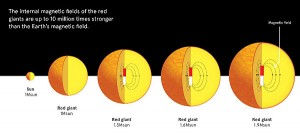Old Stars’ Fossil Fields:
Astronomers have confirmed that strong magnetic fields are frozen in place deep inside aging stars.

Stars like the Sun puff up and become red giants towards the end of their lives, so they're much larger even though the masses don't really change. The red giants ("old" Suns) of the same mass as the Sun do not show strong magnetic fields in their interior, but for stars slightly more massive, up to 60% host strong magnetic fields.
University of Sydney
University of Sydney
Stars create magnetic fields through convection, the swirling, Ferris-wheel-like motion of hot, ionized gas (or boiling water, for that matter). Where convection happens in a star depends on how massive the star is: low-mass stars, including the Sun, have convective outer envelopes around a non-convective core, but stars a little bulkier — up to a couple Suns’ worth — do have convective cores.
Recently, Jim Fuller (Caltech) and colleagues found that strong core magnetic fields could explain the oddly weak, on-and-off brightening behavior of a sample of red giant stars. These stars are low- to middle-mass and have stopped fusing hydrogen in their centers, so they don’t have convective hearts. They also often have a mismatched, variable glow, with one hemisphere brightening as the other fades. What was strange about the sample the team looked at was that this group didn’t vary as much in brightness as it should have.
Now, Dennis Stello (University of Sydney and Aarhus University, Denmark), Fuller, and their team has expanded this work to 3,600 red giants, observed with the Kepler spacecraft. The astronomers found that here, too, some red giants had “muffled” variations, but just how much they were suppressed depended on how massive the star was. For stars just above the Sun’s mass and lighter, the stars looked normal. But for the heftiest of the sample — 1.6 to 2 solar masses — about half are “depressed,” the team reported January 6th at the American Astronomical Society meeting in Kissimmee, Florida, and in the January 21st Nature.
This mass boundary between “normal” and “depressed” red giants is also the transition point from non-convective to convective cores. So this result is a nice confirmation that astronomers can track the strength of a star’s internal magnetic field using these brightness patterns. That prospect excites researchers, because magnetic fields play a big role in stars’ evolution and death, but astronomers don’t understand the details.
However, as I noted before, red giants don’t have convective cores. But they used to, before their central hydrogen-fusion furnaces shut off. So the fields muffling the variations are fossils. Magnetic fields are like strings, Fuller says, and they get twisted and tangled by the churning, convective plasma. Once this boiling motion disappears, the field essentially freezes in place. So long as there are no big, bulk motions to disrupt the field, it should just stay put.
What the team doesn’t know is whether these fossil fields will survive once the stars kick start core helium fusion, which is the next stage in their aging process. If the fields do survive, they might be the source of the strong magnetism detected in some white dwarfs, which are the final state these red giants are approaching. The fields might also explain the “extra internal mixing” that seems to go on in some red giants and their older siblings.
1 comment:
This is useful information for all if you are looking for a wildlife tour in India so Corbett National Park is one of the best places. if you want to have wildlife safari or tour so join us and get best services.
Post a Comment